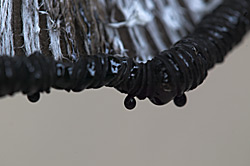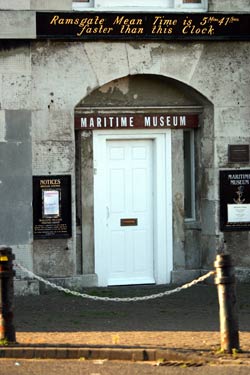Tamron SP AF 180mm f/3.5 Di LD (IF) Macro 1:1
This lens is Tamron’s offering in the longer medium telephoto macro lenses that are often favoured by wild insect and butterfly photographers as well as by those doing other forms of macro work. We take a look here at how it performs.
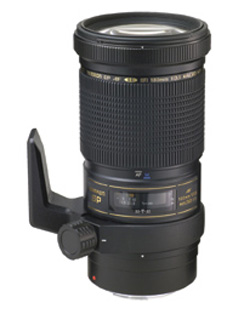 Specifications
Specifications
- Focal Length 180mm
- Aperture f/3.5
- Angle of view 14º
- Filter size 72mm
- Construction 14/11 elements/groups
- Focus type Internal
- Closest focus 0.47m (1:1)
- Weight 920g
- Dimensions 84.8x165.7mm
- Mounts available Nikon, Canon, Minolta
- Tripod bush Yes,
- Price (SRP) £739.99
Build and Handling
The lens comes packed in a dedicated, zip-up pouch with the supplied lens hood reversed over the front element. The pouch is also supplied with a clip-lock carrying strap and the lens has the usual caps front and rear. A removable tripod collar is also supplied which has a one touch turn and pull release mechanism. Completing the package is the paperwork with a multi-language instruction leaflet and the warranty documents.
Going forward from the mount the is a plain space before arriving at the tripod collar, a neat affair with a twist to loosen and a pull to remove knob which when pulled allowed the collar to hinge open and be taken away, or more likely, allows the lens to be removed from it without detaching from the tripod. In practice it worked well, although the amount of turn on the knob was minimal between tight and totally loose, thereby allowing the camera/lens combo to spin round unless supported.
Forward of the tripod mount is a distance window with the scale marked in both metric and imperial although the DOF scale marked is, by the nature of the lens, practically useless. Next up is a wide (65mm) focus ring which doubles as the MF/AF changeover switch, working in a push/pull manner. This switch, which has now also appeared on Tamron’s 90mm lens also, is a good idea and saves having to fumble for a small switch elsewhere on the lens. If you want manual focus, your hand needs to be on the ring. Pull it backwards and you have full control, a blue line appearing at the front of the ring as a visual reminder that it is engaged.
Next up, and the last before the lens hood, is a new concept by Tamron that they have called FEC or Filter Effect Control. This is a 10mm wide ring that rotates the filter thread with the lens hood in place. A neat idea indeed! It will, however, only work with dedicated filters and not filter systems such as the Cokin one.
Push the focus ring/switch away from the body and autofocus is engaged (on the Minolta mount a switch on the body should be engaged also) and focussing is done for you, although this is a rather slow and slightly noisy process. It does get there in the end, although if you go through the point of focus there is an annoying wait for it to get back there as no focus limiter is provided so it travels through the full range.
Manual focussing however, is a joy with the large ring and just a half turn from one end of the range to the other.
Optical Quality
This is the area where prime lenses are supposed to be king, and in terms of control over aberrations, distortions and contrast this is almost always the case. There is no exception here with this lens and the results out of the camera were quite pleasing. Good contrast is often, to the naked eye, one of the most important aspects of optical design and this lens does not disappoint in this area, being excellent across the frame.
Chromatic aberration was also consistently well controlled throughout the aperture range. The one disappointment was pure resolving power, which did not match up to the expectations provided by the rest of the lens.
 | Left: Fungi are a popular subject for Macro lenses, however the Tamron 180mm is perhaps a little too long for this subject, a large Shaggy Inkcap, in situ. 1/160sec at f/5.6 on a Canon 1D
|
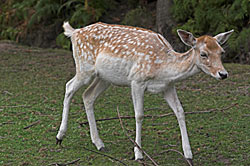 | 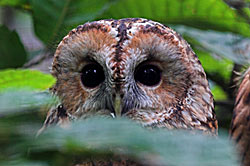 |
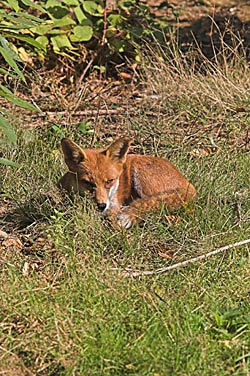 | As well as doing service as a macro lens, the Tamron 180mm can be utilised as a medium telephoto for normal subjects. A little long for portraiture, it is ideal in situations like these shots taken in a wildlife park. Creative framing can overcome the restrictions of a fixed focal length. Shot on a Canon 1D at various settings. |
Click on each comparision photo below to view full size versions
Below is our lens test data. To find out how to use these graphs look at this article: How we test lenses
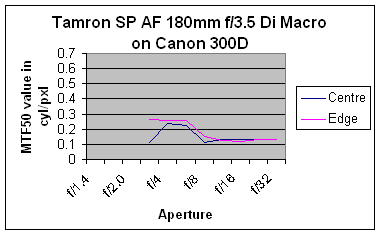
Verdict
This lens is ergonomically well designed and handled nicely. Despite it’s capabilities, it did not weigh heavily on a neckstrap and felt comfortable and intuitive to use. Usable on full frame sensors and 35mm film as well as cropped sensors, we did wonder whether the resolving power would be able to keep up with the ever-increasing pixel count of modern cameras though.
In summary, the main positive points of the Tamron SP AF 180mm f/3.5 Di are:
![]() Handles well and feels right.
Handles well and feels right.
![]() Good contrast
Good contrast
![]() Good control of distortion and aberrations
Good control of distortion and aberrations
Negative points are:
![]() Pure resolving power is disappointing
Pure resolving power is disappointing
![]() Price a little steep for performance
Price a little steep for performance
Check the latest price of the Tamron SP AF 180mm f/3.5 Di Macro 1:1 here
Test by Ian Andrews www.wildaboutkent.co.uk
Add your message
Please login here or if you've not registered, you can register here. Registering is safe, quick and free.
photodo Stats
428 MTF tests
74 in-depth photodo reviews
100+ users join each day
Help the lens community by reviewing or rating a lens today via our lens search
Latest Lens Reviews
- Chinon 28mm f/2.8 Vintage Lens Review
- Canon EF 70-200mm f/4L IS II USM Lens Review
- Samyang AF 85mm f/1.4 EF Review
- Sigma 70mm f/2.8 DG Macro Art Review
- Samyang AF 24mm f/2.8 FE Review
- Meike 50mm f/1.7 Review
- Tamron 70-210mm f/4 Di VC USD Review
- Lensbaby Burnside 35mm f/2.8 Review
- Asahi Super Takumar 50mm f/1.4 Review
- Asahi Super-Multi-Coated Takumar 135mm f/3.5 Review
